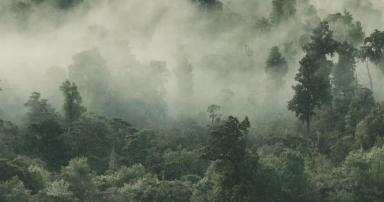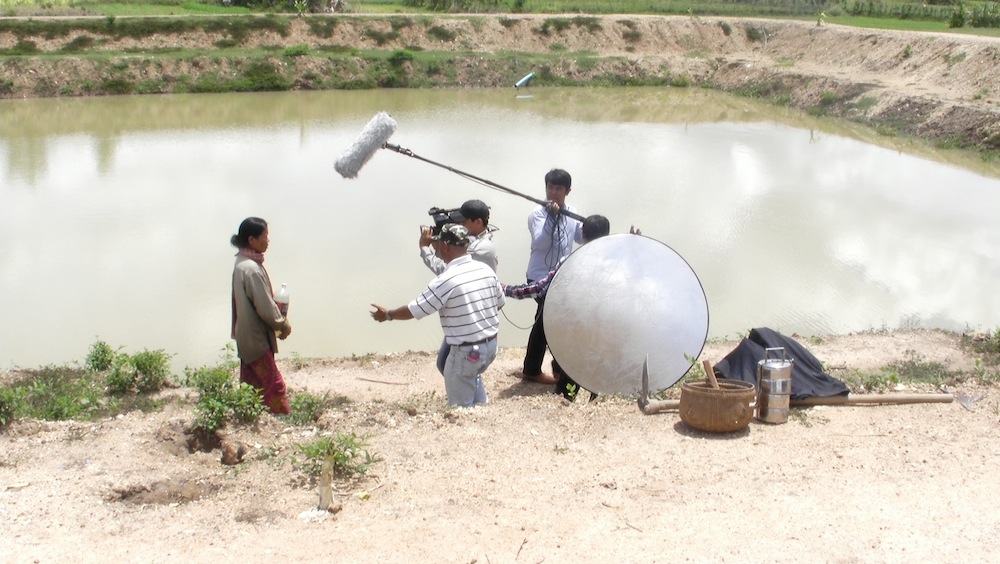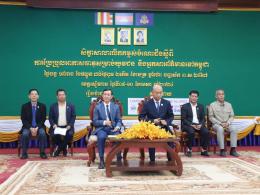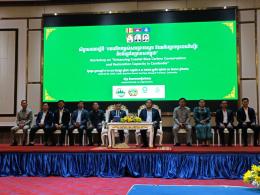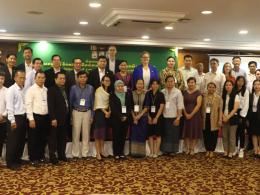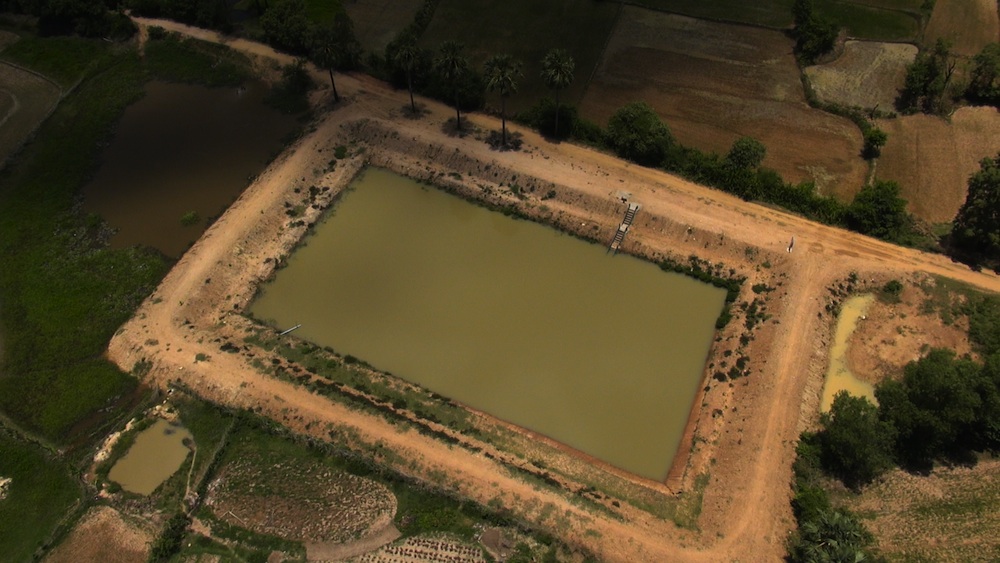
It is a hot and humid day in Bati District, Takeo Cambodia. Soon after lunch, the skies become dark, the clouds become heavy and the monsoon rain starts falling on the village of Pien Meas Kan Kat. Mr Hay Khoeun has just returned from the fields, where he was planting cactus on the edge of a newly build water reservoir. After eating his lunch, he explains that the weather has changed since he was a young boy: now it is much hotter than before. The heat amplifies important problems such as access to safe water. The area is drought prone and for at least two months each year, there is no water. All the farming activities stop. During that time, drinking water becomes scarce.
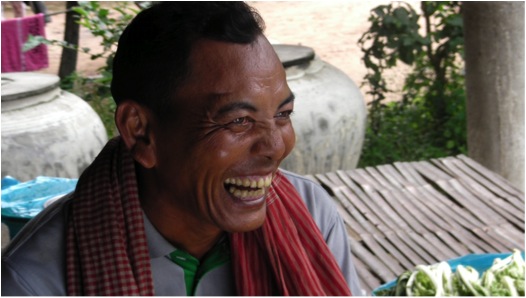 By contrast, when it rains, the people are happy. The falling rain - abrupt, and dense will last for an hour then will stop as fast as it started. Mr Hay takes advantage of this time to take a shower. He laughs out loud but his voice is barely audible in the rain: ‘This is the water from yesterday’s rain. It was the first in the season – normally, this jar is empty.’ His smile tells a lot about the value of water for people here: ‘in Phnom Penh, you turn the tap and you have water but you do not value it. In this jar, it is my hand taking the water – I know what is it is worth…’
By contrast, when it rains, the people are happy. The falling rain - abrupt, and dense will last for an hour then will stop as fast as it started. Mr Hay takes advantage of this time to take a shower. He laughs out loud but his voice is barely audible in the rain: ‘This is the water from yesterday’s rain. It was the first in the season – normally, this jar is empty.’ His smile tells a lot about the value of water for people here: ‘in Phnom Penh, you turn the tap and you have water but you do not value it. In this jar, it is my hand taking the water – I know what is it is worth…’
There is also another person smiling nearby: Mrs Toich Sem – his wife. They were born and raised in the same village and married in the traditional way. They are both very resilient people and make a strong couple: ‘Today, women and men have equal roles – what men do, women can do too. It is not like before. Now, women and men can do things together…Women do not only take care of the house. We work in the fields with the men as well. We help in the commune Council. When we decided to make the reservoir, the women joined in the same as the men.’
The reservoir she refers to is the result of a local pilot project that has global resonance. The reservoir is 60m x 30m and about 10 meters deep. It was made to stock drinking water for over 800 families living in the commune. It is the first year that the villagers can benefit from the reservoir and clearly it brings a strong sense of relief for everyone.
A large part of the success of this project is due to the national ownership of the project: it was managed by the National Committee for Sub-National Democratic Development Secretariat with technical support from the Ministry of Environment’s Climate Change Department. Seen as a potential model, the project benefited from support of multiple development partners including the Cambodian Climate Change Alliance with (supported by UNDP, the European Union, Sweden and Denmark), and UNCDF.
This project was among the first worldwide to mainstream climate change in local development processes. The idea is to provide financial and technical support to climate-proof development projects in local planning, with both hard approaches like infrastructure (higher roads, irrigation canals, reservoirs) and soft technologies (such as awareness and capacity building of local authorities).
In this commune, residents were quick to identify their priorities: drinking water. So the idea of a reservoir that could outlast the drought was not a surprise. But to achieve this local project, the central government had to start integrating climate financing and climate change analysis in local governance structures.
In fact, this activity pioneered climate change mainstreaming in the planning and budgeting process of selected districts and communes. Only two countries in the world initially benefited from this approach: Bhutan and Cambodia. Given the potential, this initiative is now being replicated not only in other parts of Cambodia but also in many other countries in the world, particularly in Africa.
T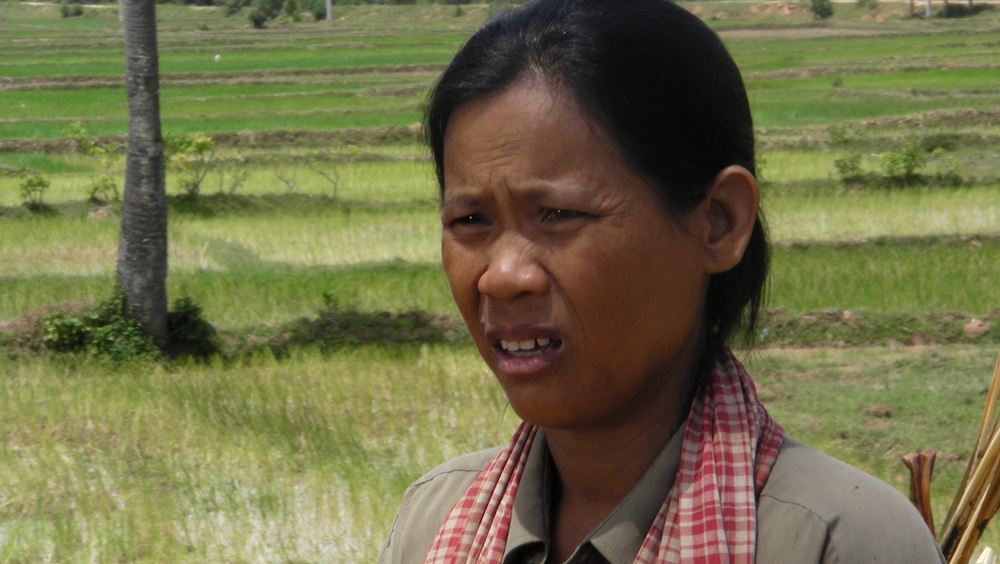
As we walk around the reservoir, less than a kilometre from her village, Mrs Koich explains: ‘Last year, we had to go and get water from a well behind that hill you see in the distance – and when the water ran out in that well, we had to go to the next well even further away – you need to go at 4AM otherwise you would have to wait in queue because everyone was going there as well. Some people also used to buy water to avoid spending time but when there is no water at all – even money is futile. Our life has changed completely. Our animals used to get sick during the drought. Some died. It was hard for all of us. But now we look to the reservoir and we can think about the future. Next time, when you come, you will see the water tubes – connecting the nearest houses to the reservoir. If we had the money, we would do it too – maybe we can afford to do it next year…
This article was written by Cedric Jancloes with Sem Tola, during the filming of an advocacy video on the climate change activities of the Cambodian Climate Change Department in August 2013.
Photos by Action IEC - Aerial footage by Action IEC, Kontomroy and Made-in-Mars for CCCA.
Top: The reservoir / Right: Mr Hay Khoeun – happy after the rain / Left: Mrs Toich Sem Interviewed / Bottom: Mrs Toich Sem being filmed by the video crew of CCCA

